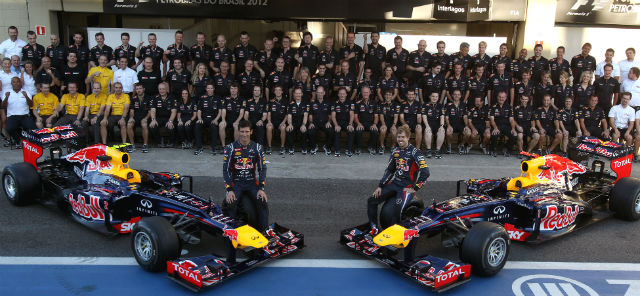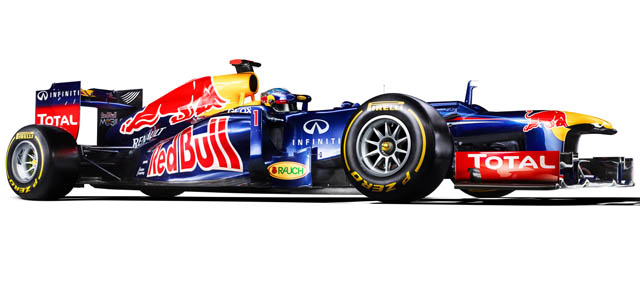
The Red Bull RB8 is Adrian Newey’s 23rd Formula 1 car and the fourth in a family of evolutionary designs dating back to the RB5 of 2009. Despite being a direct evolution of the 2011 World Championship winning RB7 the RB8 regulation changes have forced Newey and his team at Milton Keynes, England to develop new design concepts.
Subscribe to Racecar Engineering
Keep up with the latest developments in motorsport technology with Racecar Engineering, the world’s leading publication for technical insight.
Save up to £33 when you subscribe and never miss an issue
Choose from our Print, Digital and iPad editions
“We have lost the exhaust technology with the restriction exhaust outlet position that we were able to develop and perhaps be ahead of the pack on in the last couple of years, that led to a big re think over the winter. Whether that will affect us more than other people is difficult to know of course. We designed the RB7, last year’s car, around that exhaust position and were probably the only people to do so, so it may be that we’ve lost more than other people through that” explains Newey. “We’ve had to go back and look at how we developed the car through the last one and two years with the side exit exhaust and try and, if you like, make sure that the routes we had taken that were only suitable for that exhaust position we now had to re-evaluate. Probably one of the key things there is the rear ride height. The exhaust allowed us to run a high rear ride height, it’s much more difficult without that to sustain a high rear height so we have to go back down and have to redevelop the car around that lower ride height.”

The RB8 does appear however to still run a relatively high rear compared to some other cars on the grid, such as the Ferrari 663 (below)

A lot of attention has been paid to the large duct on the nose hump of the RB8, speculation suggests that it has some aerodynamic influence on the front wing or the region under the nose. Newey denies these claims claiming that “it is simply for driver cooling, we relocated the opening which is normally on the tip of the nose of the car back to the hump for aesthetic reasons.”

Few are accepting this explanation as the duct would be by far the largest in use in Formula 1, Craig Scarborough (see @scarbsf1 on twitter) has speculated that the top edge of the duct could bring key gains but without a full explanation from Red Bull or putting the car in the wind tunnel, all of this remains mere speculation.

The rear of the car retains the pullrod suspension seen on all recent Newey Red Bull’s. With a very tight rear end as has been a trait of this high achieving family of cars.
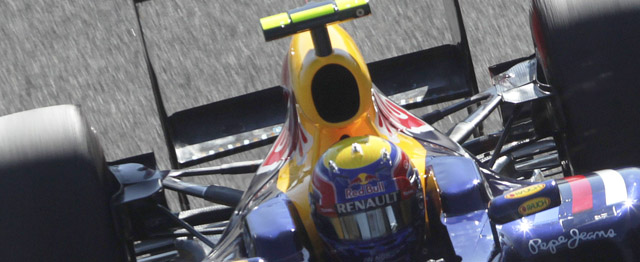
The car features many other evolutionary design elements from the RB5, RB6, RB7 family including the roll hoop. This is a direct carry over from the RB7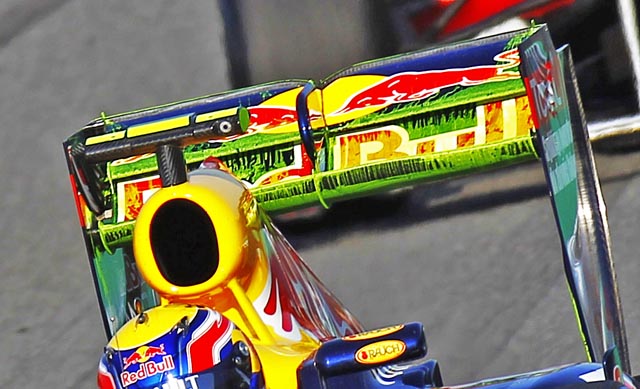
It is almost impossible to tell the two apart – RB8 is below and RB7 above. This evolutionary approach to the design of the car – would in some areas of the sport be dubbed RB7+ or RB7 evo. However the RB8 does feature a new monocoque not only due to the nose height but also due to the use of a smaller ATL fuel cell, another impact of the exhaust regulation changes.
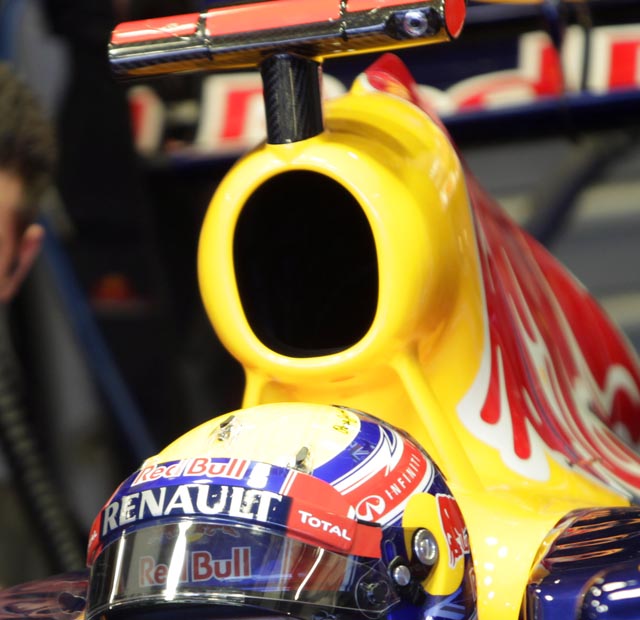
At the front of the car the family lineage is clear again, aside from the regulatory nose hump and mystery duct (“driver cooling”). The stay on the splitter seems to be incredibly thin.
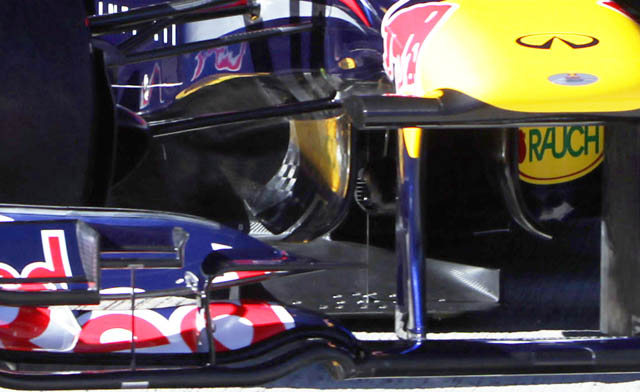
From the side you can see just how slender the stay is and the complex arrangement around the sidepod duct. The stay is also fitted with a sensor in this image.

The first outing for the car at Jerez revealed a number of details on the car not present in official photos from Red Bull such as the diffuser and cooling outlets (below). The yellow arrow points to the starter input shaft.
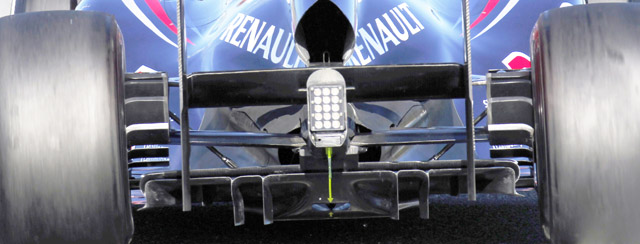
The exhaust location on the RB8 seems to be fairly conventional but this is the first iteration seen on the car and Newey plays down the potential influence of exhaust gasses and tailpipe location “as there is not much to come from it you are seeing a wide variety of solutions.” 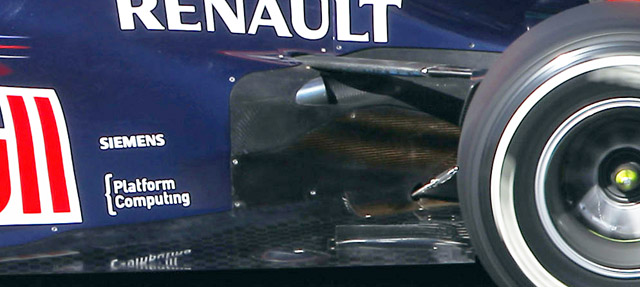
Note how closely the exhaust tail pipe sits to the upper wishbone, blowing directly onto it.
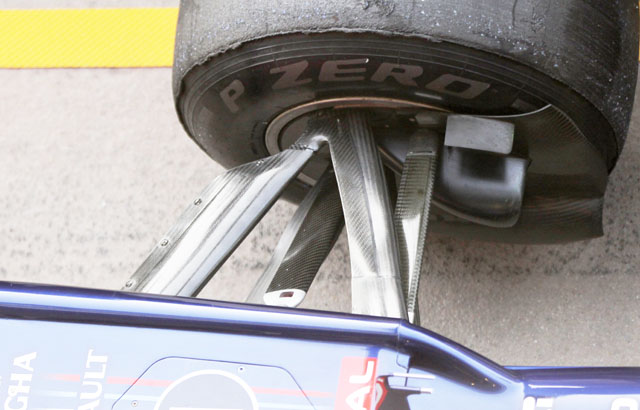
The RB8 has deceptively simple looking brake ducts at the front. Note the small winglet on the top of the duct – these mini wings are allowed as they are considered part of the brake cooling and not to generate downforce, which they almost certainly do (above).
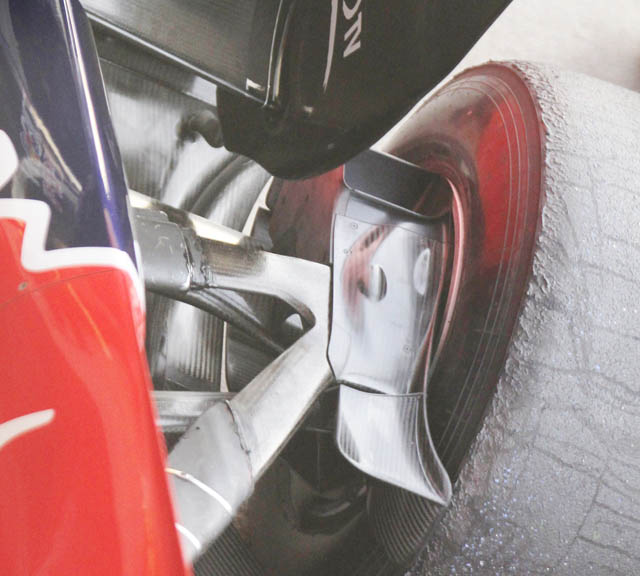
A look at the rear brake ducts shows a few interesting details, not the duct exit at the back of the upper portion. It is hard to really assess its design without a wind tunnel!
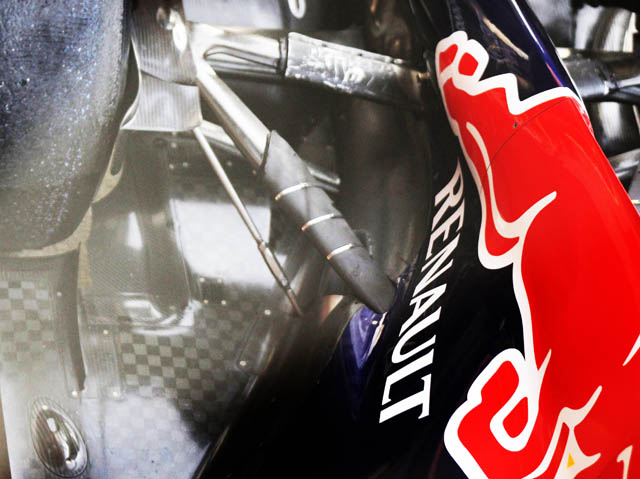
The rear suspension above shows just how much metal Red Bull has had to employ to position the exhaust exit so close to the upper wishbones, the shot also shows some interesting details around the floor of the car, note the ‘batman’ section protruding close to the tyre. The small turning vane may well also have something to do with channeling exhaust gasses.
Test 2: Barcelona
The programme at Barcelona was seemingly dogged with a lot of small issues, gearbox faults, and oddly the air temperature was too low at one point. Head of Race Engineering Ian Morgan said “It was again so cold one morning that we had problems with pit stop practice, simply because the equipment was freezing up as we tried to use it. After that we ran a bit of a free practice simulation, but we discovered a small problem, which lost us some time. It was only a minor issue and didn’t require major work, but it meant that we had to run a compressed Quali simulation before lunch. Afterwards we got through a whole race distance, which, at the car’s first go, is always very encouraging.”
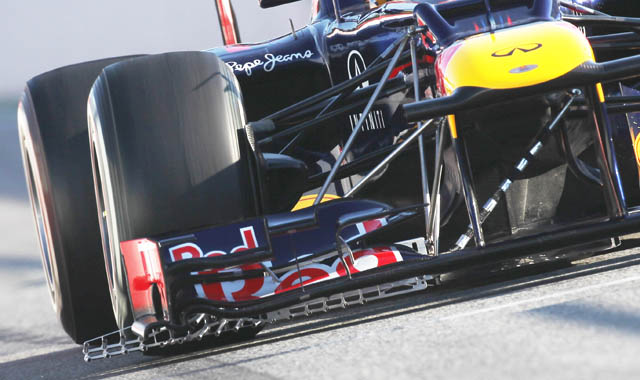
Red Bull equipped the RB8 with a number of airspeed sensor arrays, like many other teams did at the test. The one above has a large number of pitot tubes, unlike the Williams and McLaren arrays it seems that the Red Bull version is not motorised. Some of the pitot tubes are angled upwards others outwards (see below) in order to accurately log the airflow in the wake of the front wing.
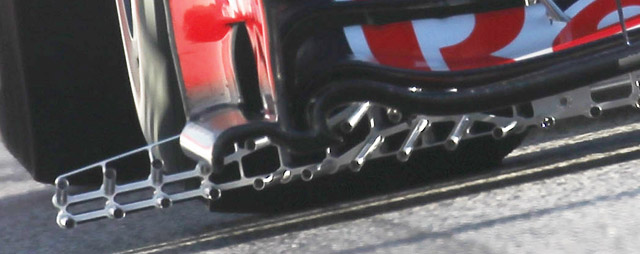
From the angle of the inner tubes it suggests that the lower elements of the RB8 front wing act as turning vanes diverting flow inside of the front wheels, and likely flowing on along the flank of the car to the rear. Meanwhile the endplate seems to be guiding the flow downward around the outside of the wheel.

Another array was fitted above the tea tray of the car at one point but unfortunatley we only have a picture of its mounting structure (below) so we cannot say for sure what it is for, however it is likely to support a similar pitot tube array.
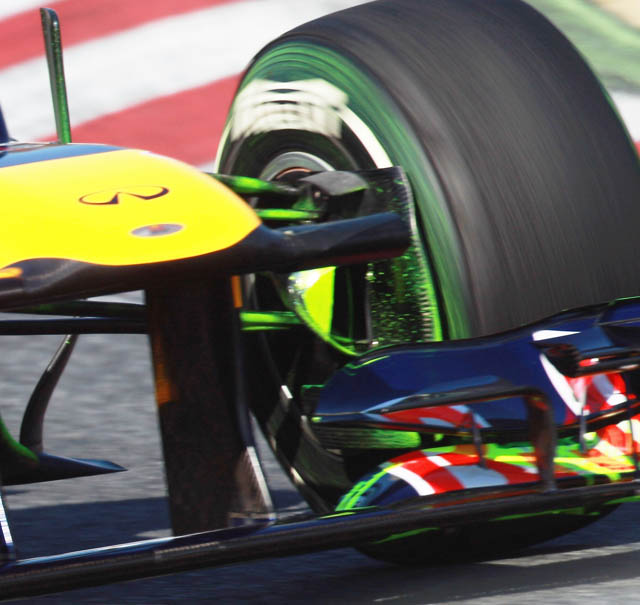
The team also conducted some flow vis work, again concentrating on the outer edge of the front wing (above)
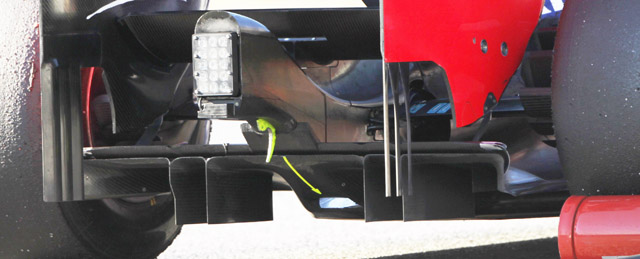
The test also allowed for an interesting look at the diffuser on the RB8, and how far the strakes go into it – which is not that far at all!
Test 3: Barcelona (again)
After three relatively trouble-free weeks of testing, Red Bull Racing faced a number of issues on its final day of testing in Barcelona, which restricted Sebastian Vettel’s time on track that day. “I’d love to be able to say more about today, but this morning I had an issue, I went off track and broke the front wing and had to come in,” Sebastian said. “It took quite a while to get back out and then just before lunch we had a problem with the gearbox so it upset the whole day. After that there wasn’t much we could constructively do. To be honest, it wouldn’t be fair to judge the updates we have, as I didn’t get many laps today. I think yesterday was quite a decent step and it was a good day for Mark, so we’ll take what we can from that.”
Sebastian’s Race Engineer Guillaume Rocquelin added: “We’ve had a pretty smooth run all the way through pre-season and to have such a disrupted day on the final one is pretty disappointing. We hardly had any running in the morning and when we did manage to get out in the afternoon there really wasn’t much we could achieve in the short time available. It’s frustrating as the boys worked really hard all day. But when things like this happen you just have to roll with the punches. If there is a positive to take from today it’s that it happened on the final day and otherwise Seb has had a pretty good run through the three tests. We’ve learned a lot, progressed the car well, I think, and now we’ll just look forward to taking it racing, where it really counts.”
Red Bull rolled out a new RB8 chassis during the Barcelona with significant updates apparent, but the poor track conditions interrupted the development runs.
Mark’s Race Engineer, Ciaron Pilbeam explains: “We had a new chassis for Mark today with some developments parts on board. The run plan was pretty much the same as yesterday, concentrating on set-up work and short runs in the morning and with longer runs planned for the afternoon. Unfortunately, because of the rain we had we didn’t get to complete all of the programme. Some people opted to run in the wet but we chose not to, as for us the track was neither one thing nor the other; not wet enough to gather the data we would have wanted and not dry enough to make it worthwhile running.”
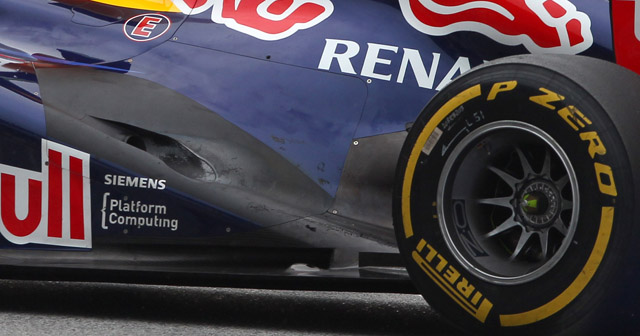
During the Barcelona test Red Bull shipped in a new chassis, packed with updates. Significantly it included a Sauber C31 style exhaust (above) and substantially revised rear bodywork.
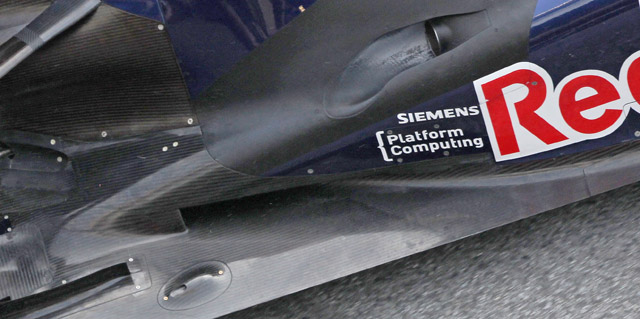
At the termination of the sidepod undercut there is a curious duct, which appears to be feeding the underfloor of the car with air from the front wing. It is even more interesting due to its location downstream of the exhaust exit. One of the things teams are specifically forbidden from doing in technical directives is the addition of exhaust gas capture ducts. Red Bull will have to prove somehow that this does not carry out such a function.
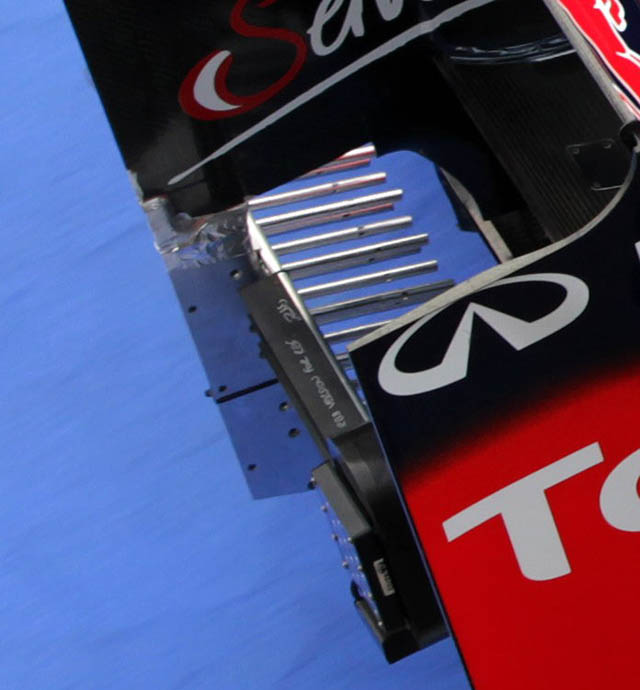
With such major revision at the rear it is worth taking a closer look at the changes to the diffuser, and that it exactly what Red Bull themselves did with a sensor array packed with pitot tubes (above) In this shot we also get a nice view of the section od the rear portion of the end plate which appears to thicken in the centre just above the Infiniti logo. As well as the array an additional pitot tube was mounted above the rear wing end plate (below).
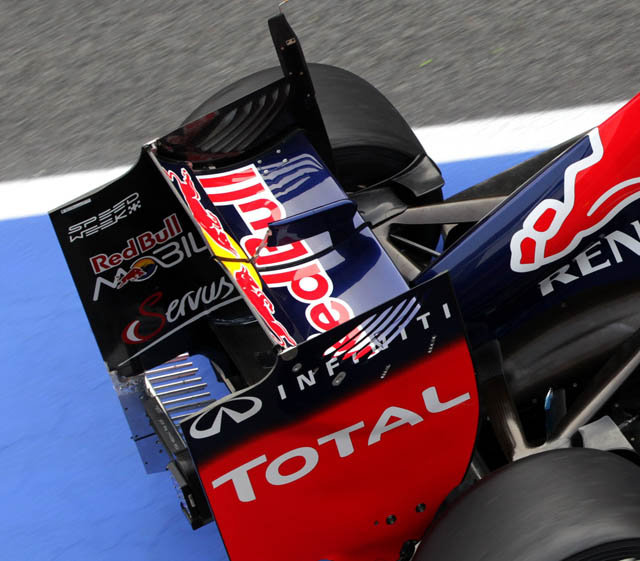
Looking at the new diffuser it is clear that much is carried over from the Jerez spec design, but an additional turning vane has been added above the third strake from the centre of the car. This is almost certain to be part of the exhaust strategy.
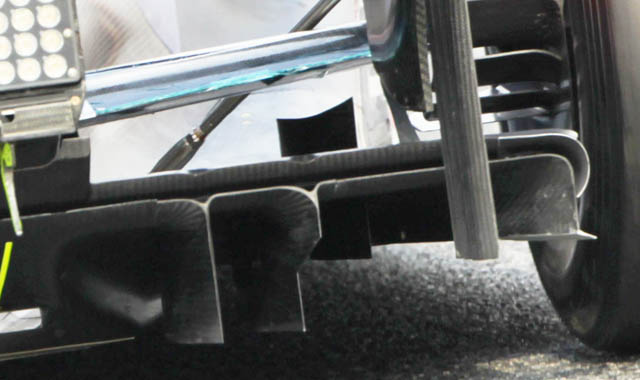
The sidepod turning vane links have been revised to a concept similar to that used on the Sauber C31 but not as extreme.
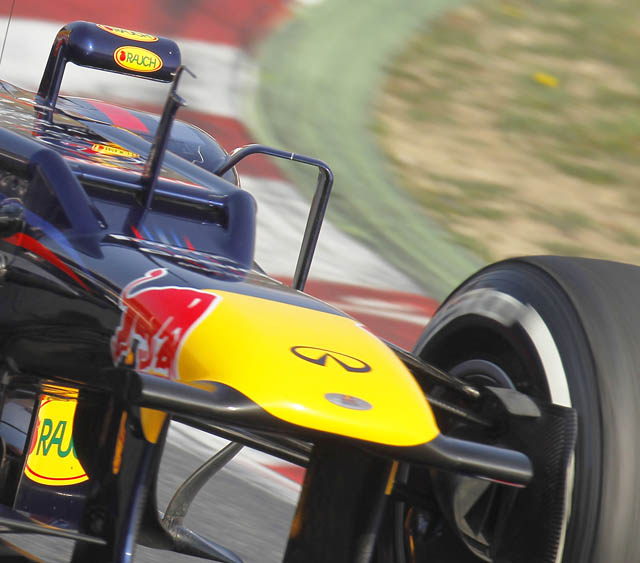
The link to the sidepod has been raised from is previous location (below) to the new bridge layout (above).
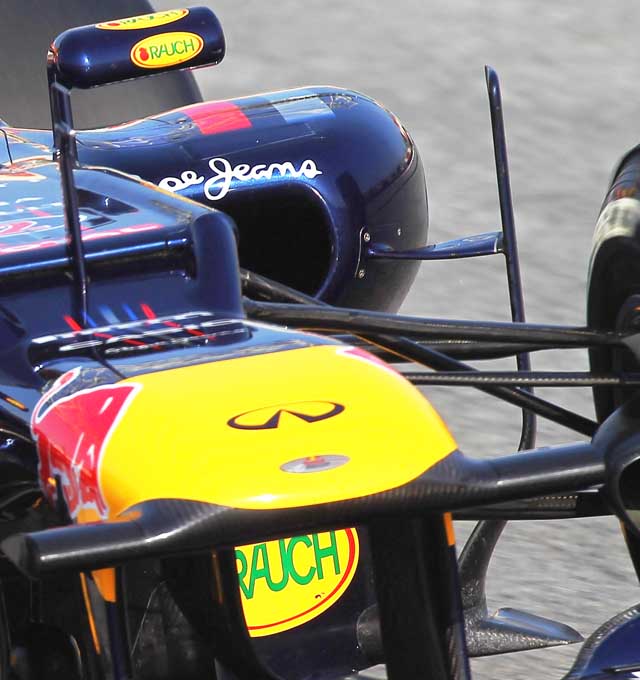 The bridge links the sidepod to the turning vane in a way that is purely dictated by the cars aerodynamics, it is likely to smooth or channel the airflow in a way or direction that works with the new exhaust position.
The bridge links the sidepod to the turning vane in a way that is purely dictated by the cars aerodynamics, it is likely to smooth or channel the airflow in a way or direction that works with the new exhaust position.
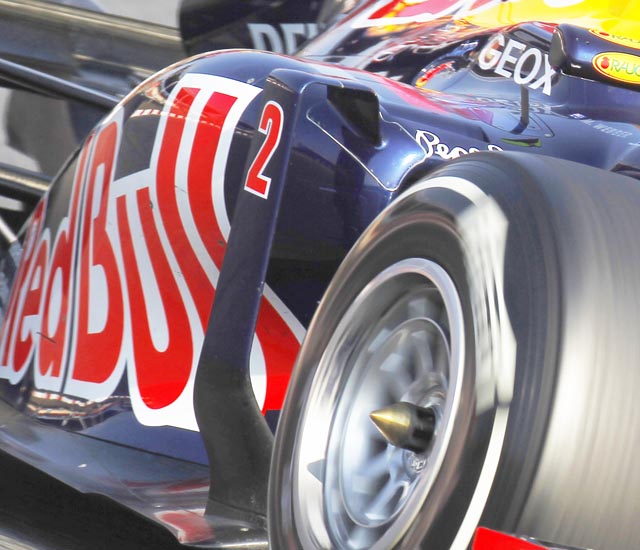
On top of the sidepod the car has gained an extra duct (below), very similar to the solutions found on recent McLarens and Ferraris. The image also shows the upper portion of the sidepod turning vane bridge well.

The update kit also includes yet another additional cooling duct just behind the cockpit, this “Geox duct” is similar in concept to the gills seen on the Sauber and Force India (below).
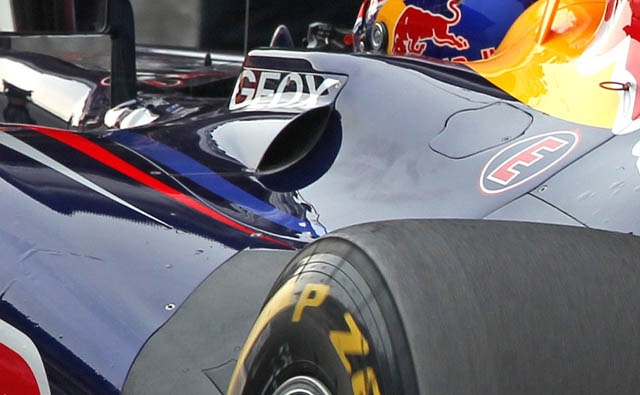
Melbourne
Car 1: Chassis (not disclosed)
Position: 2nd
Driver: Sebastian Vettel
Car 2: Chassis (not disclosed)
Position: 4th
Driver: Mark Webber
The world champions did not appear to be much of a match for McLaren at Melbourne. But the RB8 clearly has pace and is likely to win a lot of races. However the achillies heel of the RB7 raised its head once again in Qualifying as Mark Webbers car suffered a KERS failure.
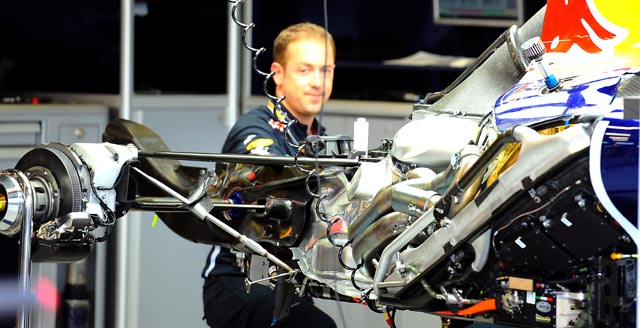
Red Bull uses a Magneti Marelli KERS, which is similar to the system used by Lotus and Ferrari amongst others. Some of the hardware is just visible in the picture above (bottom right). With the orange HV loom heading straightbackwards it suggests that once again Red Bull has mounted its batteries around the transmission.

For Melbourne Red Bull had again revised the exhaust layout of the RB8, refining the Sauber style outlets first seen at Barcelona.
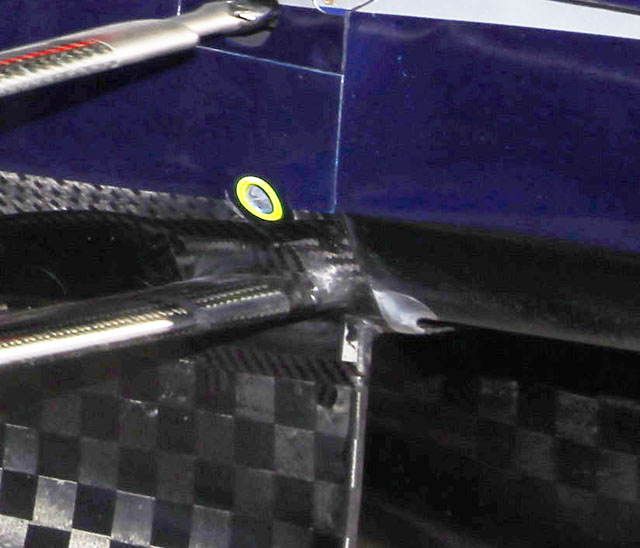
A second nose duct has emerged on the RB8, fitted on the cars underside and just visible in the picture above and below. Where this air is fed is still not clear, and shots of the bulkhead have also not really resolved the exact nature of the upper duct despite speculation online.
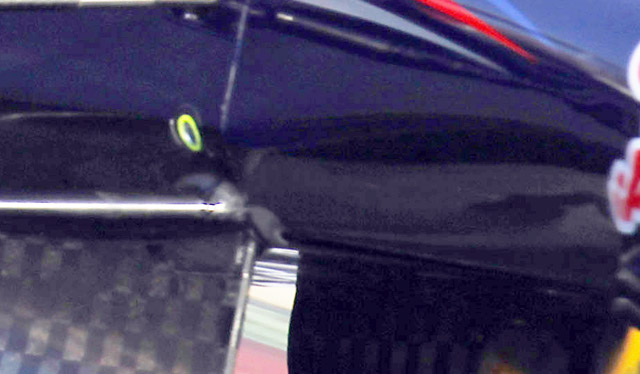
Sepang
Car 1: Chassis (not disclosed)
Position: 11th
Driver: Sebastian Vettel
Car 2: Chassis (not disclosed)
Position: 4th
Driver: Mark Webber
The RB8 features a naca duct style cut out in its under nose spaniel ears, one of many tiny aero details on this complex car. Nose duct also visible
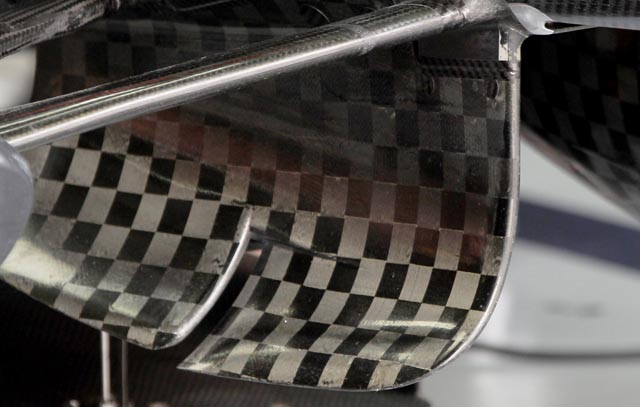
A good look at the RB8’s front bulkhead shows very clearly the location of the lower duct. Its purpose is not yet clear, rather like the upper duct, claimed to be for driver cooling. It appears in a section of the tub which appears to be binded ontop of the main structure. It is not clear if this feeds into the cockpit or elsewhere.
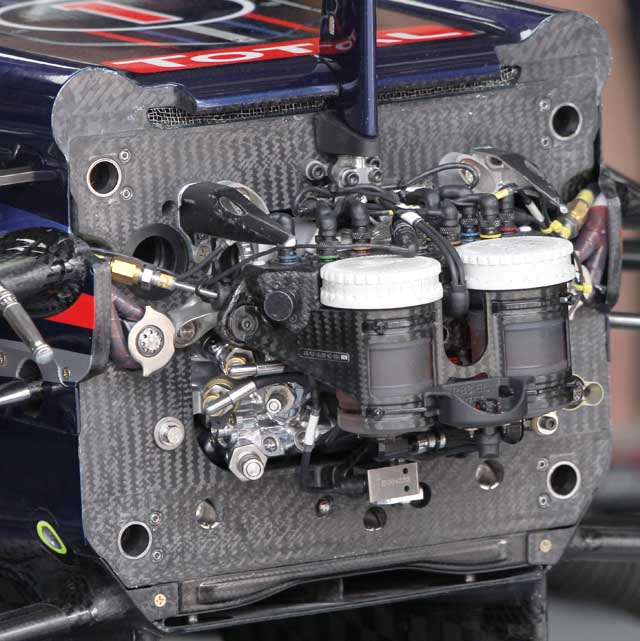
Shanghai
Car 1: Chassis (not disclosed)
Position: 5th
Driver: Sebastian Vettel
Car 2: Chassis (not disclosed)
Position: 4th
Driver: Mark Webber
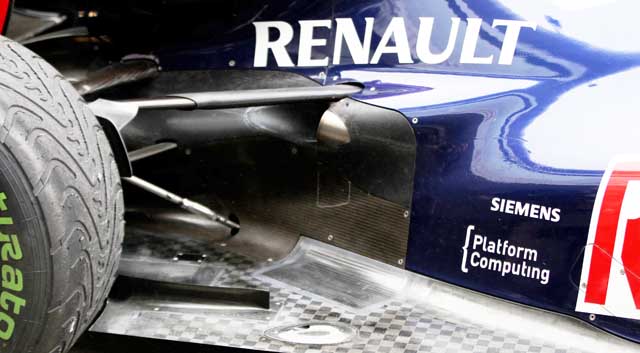
Red Bull’s two RB8’s appeared in different specification, Vettel’s car appeared in the specification it ran in winter testing, whilst the car driven by Webber had a major update on it. Key to the differences was the exhaust layouts – Vettels version is close to launch spec (above) and Webber ran the latest selup (below)
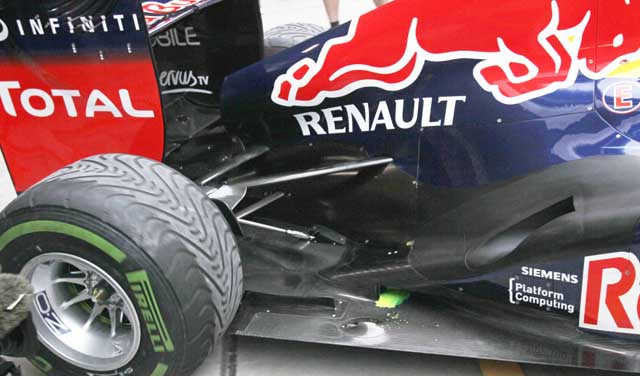
The camera mounts were revised at the last race and both RB8’s carried the new layout.
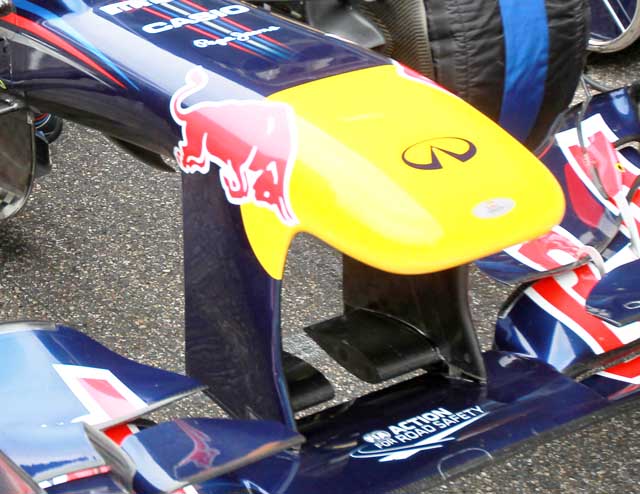 With the cameras relocated from the nose (above) to the space between the wing supports (below).
With the cameras relocated from the nose (above) to the space between the wing supports (below).
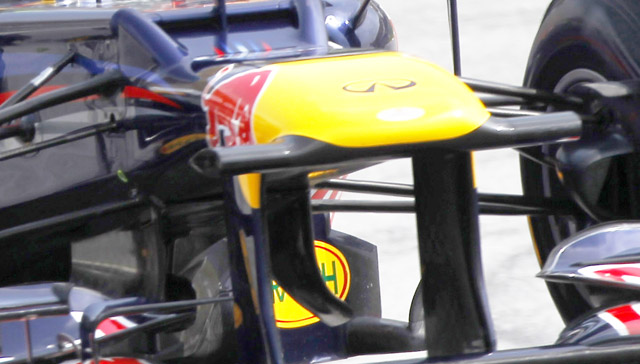
A new rear wing was installed using a centre support instead of the end plate supports used up until this point. Though it was not used much.
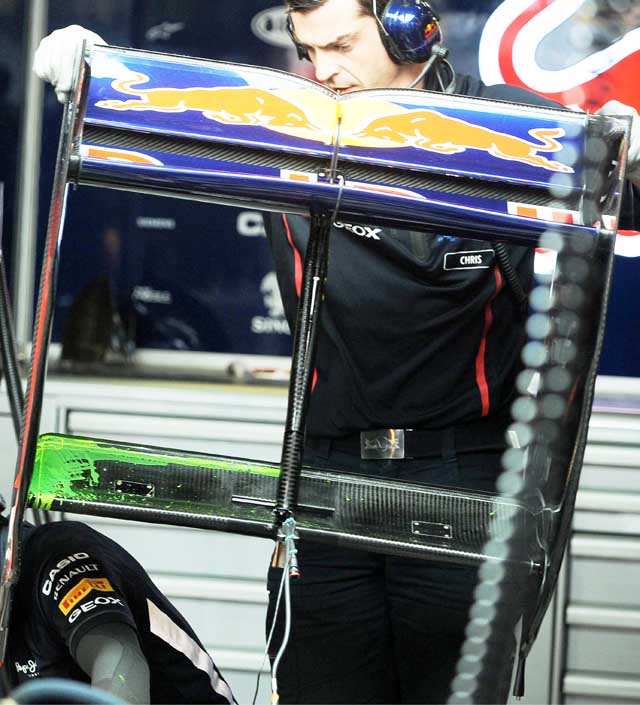
A good look at the RB8 front brakes. Note the drilling shape and the Brembo caliper
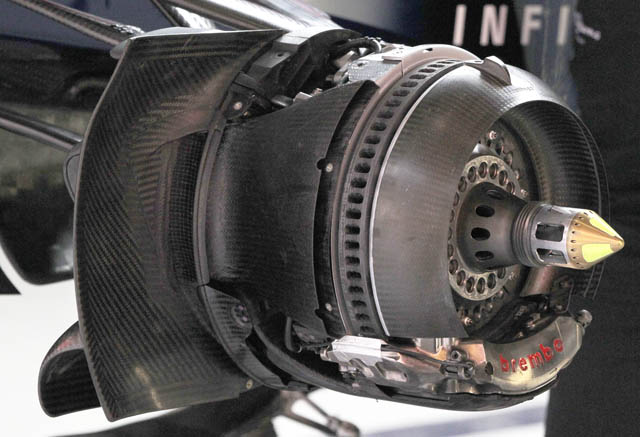
Under the engine cover we can see more detail of the RB8’s powertrain. Note the way the exhaust comes forward and returns rearward. It will be interesting to compare this layout with that of the Caterham CT01 or Lotus E20
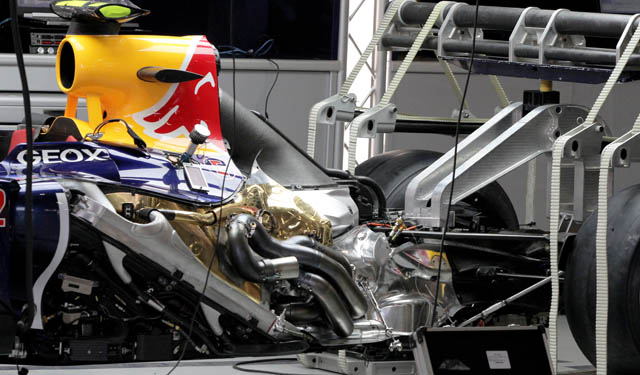
Bahrain
Car 1: Chassis (not disclosed)
Position: 1st
Driver: Sebastian Vettel
Car 2: Chassis (not disclosed)
Position: 4th
Driver: Mark Webber
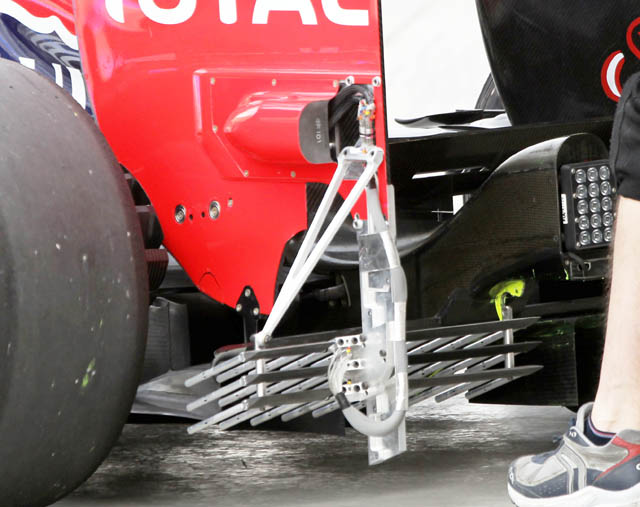
Red Bull filled in the tunnel seen at earlier events, reverting to a blanked off lower body section. To study its influence Red Bull used both flow vis and a sensor array on the rear of the car.

It is unusual to see both techniques employed at the same time but this is exactly what Red Bull did in free practice.
Test 4: Mugello
Car: RB8 (chassis not disclosed)
Drivers: Mark Webber, Sebastian Vettel
During a productive session, the team managed to get through its full planned programme, which focused largely on aerodynamic testing. Having amassed a vast amount of data over the past three days, the team will now return to its Milton Keynes base where analysis can take place in the run-up to next week’s Spanish Grand Prix.
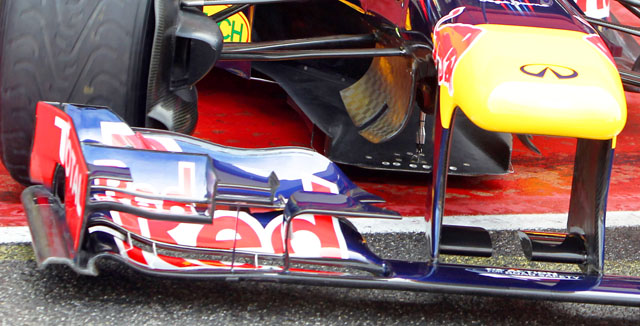
A new front wing was fitted to the RB8 at the test, compare with the alternative version below – note the repositioned nose cameras. A sensor array was also fitted.
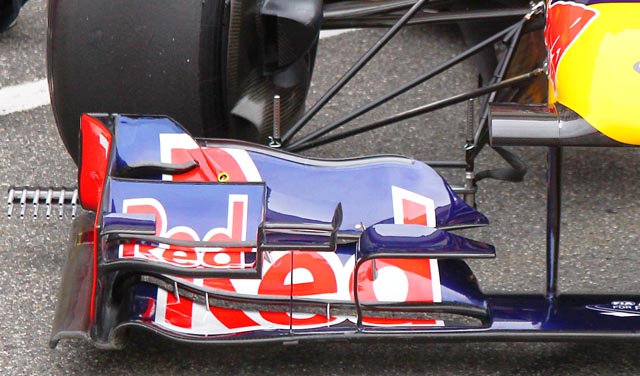 Understanding the airflow around the RB8 was clearly a critical part of testing for Red Bull below we can see another very large sensor array one of the motorised versions mounted behind the front wheel, clearly analysing wheel wakes.
Understanding the airflow around the RB8 was clearly a critical part of testing for Red Bull below we can see another very large sensor array one of the motorised versions mounted behind the front wheel, clearly analysing wheel wakes. 
Barcelona
Car 1: Chassis (not disclosed)
Position: 6th
Driver: Sebastian Vettel
Car 2: Chassis (not disclosed)
Position: 11th
Driver: Mark Webber
Monaco
Car 1: Chassis (not disclosed)
Position: 6th
Driver: Sebastian Vettel
Car 2: Chassis (not disclosed)
Position: 1st
Driver: Mark Webber
Christian Horner in the Team Principal’s corner:
“It’s a fantastic result for the team to achieve a third consecutive victory in Monte Carlo. Mark drove an immaculate race and after a very clean get away, he controlled the race from the front. We weren’t sure if it was going to be a one or two-stop strategy heading into the race, but Mark did such a good job on the soft tyre that he bought the option to make a one-stop really work and delivered the pace when he needed to. Despite some heart stopping moments in the last few laps, he controlled his pace fantastically well and never looked under threat. With Sebastian, after a good start he was in a high speed train in sixth place until all the soft runners pitted and then he had his window of opportunity to put in some really competitive lap times on the worn hard tyre and that, together with a fantastic pit stop today, enabled him to jump both Felipe Massa and Lewis Hamilton. So first and fourth is a great team result, it’s great to achieve a result like this, especially when all our partners are here in the Principality. All the races carry the same amount of points, but some are that little bit more special to win.”
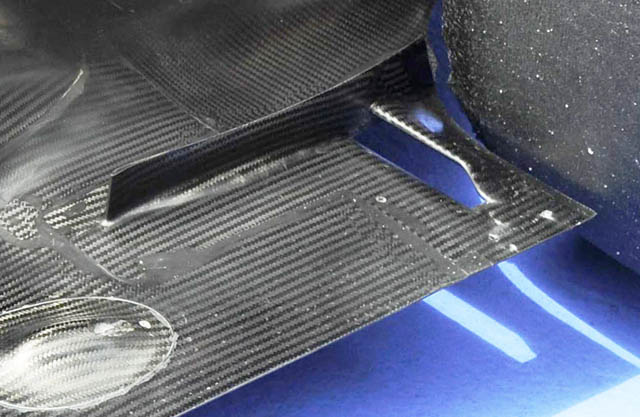
The floor on Red Bull’s RB8 has been deemed illegal after a clarification was issued by the FIA. At the Spanish and Monaco Grands Prix the car ran with a revised rear floor featuring a hole (above) ahead of the rear wheel.
It was a design feature questioned by a number of teams who thought that it contravened regulation 3.12.5, which states
3.12.5 All parts lying on the reference and step planes, in addition to the transition between the two planes, must produce uniform, solid, hard, continuous, rigid (no degree of freedom in relation to the body/chassis unit), impervious surfaces under all circumstances. Forward of a line 450mm forward of the rear face of the cockpit entry template, fully enclosed holes are permitted in the surfaces lying on the reference and step planes provided no part of the car is visible through them when viewed from directly below.
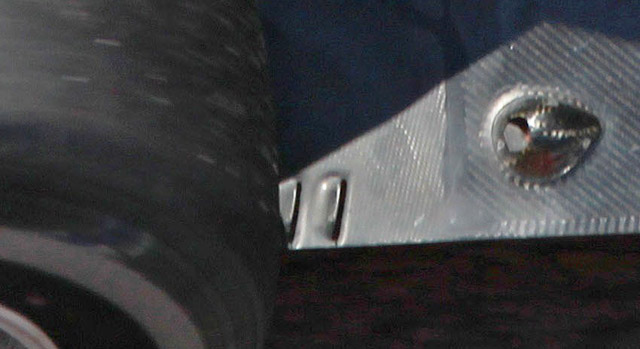
A number of teams including Ferrari have similar holes in the rear floor but they are linked to the outer edge despite the fact that it is almost impossible to put a piece of paper in the section between the slot. This can clearly be seen in the image above. These are legal however as the slot makes them not fully enclosed. These holes draw air in ahead of the inner face of the rear wheel to help reduce the impact of a vortex generated by the rotating tyre on the diffuser.
The FIA clarification reads;
“Following on from a number of discussions in Monaco, during which it became clear that certain misunderstandings existed, we feel it would be helpful to make our position clear with respect to the presence of a fully enclosed hole in any surface lying on the step plane. It has been argued that, as it is not explicitly stated that fully enclosed holes cannot be located in a surface lying on the step plane rearward of a line 450mm forward of the rear face of the cockpit template, then they may be located in such areas. We disagree with this view and consider it implicit that fully enclosed holes may not be located there.”
As a result Red Bull will have to change the design of the RB8’s floor likely by making a Ferrari style cut to the outer edge. The results of the Monaco Grand Prix and the Spanish Grand Prix will stand as no protest was lodged, further Joe Saward points out that “The Red Bull has not been declared illegal. The FIA Technical department has said that in its opinion the floor does not meet the rules as it interprets them. If red Bull wishes to go on using the floor they can. They would then be reported to the FIA Stewards, who would rule on whether the opinion of the FIA Technical department was correct or not. If Red Bull did not agree with that, it could appeal to the FIA International Court of Appeal.”
Montreal
Car 1: Chassis (not disclosed)
Position: 4th
Driver: Sebastian Vettel
Car 2: Chassis (not disclosed)
Position: 7th
Driver: Mark Webber
CHRISTIAN HORNER: “A tricky race. Having been in the lead at the start, it was obvious early on that we were a little bit harder on the tyres, which necessitated Sebastian to pit earlier than we wanted. That permitted Hamilton and Alonso to get the jump on us. Then there was a dilemma as to whether we do a one or two stop race. We were going well on the tyres and at that stage it seemed our best option was to do a one stop. But then the tyres really started to go away from us, so we made a late call to go on to the super soft tyres, which enabled us to get back up to fourth position, behind the one-stopping Grosjean and Perez. With Mark, again we were running okay early on. He had an engine hesitation in the first few laps, but then he settled into a good rhythm. Again we were heavy on the tyres towards the end of the stints and it was clearer with Mark to go to a two stop earlier, but unfortunately the one stoppers managed to get ahead. So, a tactical race, a tricky race, but nonetheless we have still managed to salvage respectable points today.”
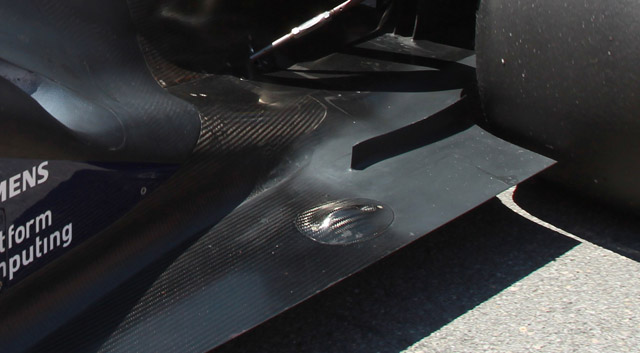
The updated floor was evident in Canada, with the ‘illegal’ versions modified to remove the hole. It is clear to see where the carbon fibre has been modified in this pic taken on the grid in Montreal.
Valencia
Car 1: Chassis (not disclosed)
Position: DNF (Alternator)
Driver: Sebastian Vettel
Car 2: Chassis (not disclosed)
Position: 4th
Driver: Mark Webber
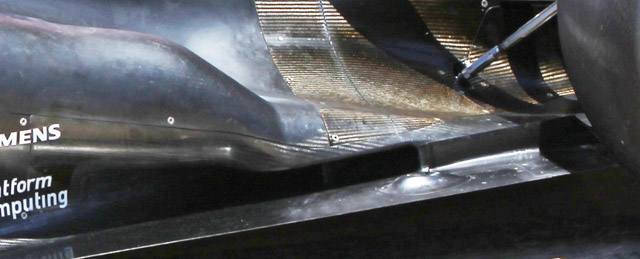
The RB8 was heavily updated when it arrived in Spain (yet again) most of the modifications were focussed on the rear end of the car. Bodywork around the exhaust was again modified as Red Bulls understanding of the 2012 rules set increased. A large tunnel was fitted under the exhaust exit with one channel feeding the starter hole and the other exiting above the diffuser

The bodywork ahead of the rear wheel was also modified, compare with the hastily revised version seen in Montreal.
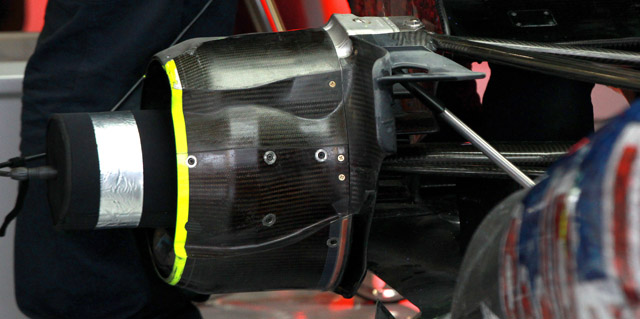
The rear brake calipers have been relocated from the slightly angled position in front of the rear axle to the bottom of the disc. New uprights have also slightly revised the outboard geometry. (Pictured at Silverstone)
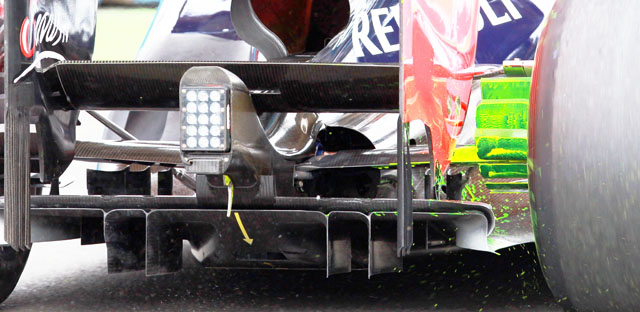
Further updates to the rear end include slightly larger strakes above the diffuser, also note the visible started hole and flow vis paint on the winglet cascade.
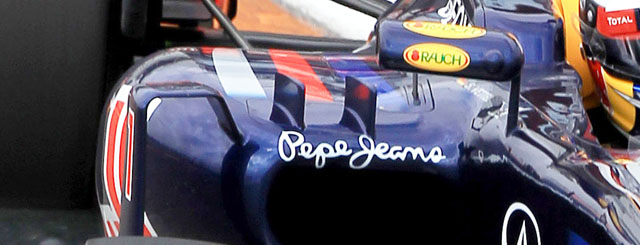
Finally the RB8 was fitted with the now common sidepod turning vanes.
Silverstone
Car 1: Chassis (not disclosed)
Position: 3rd
Driver: Sebastian Vettel
Car 2: Chassis (not disclosed)
Position: 1st
Driver: Mark Webber
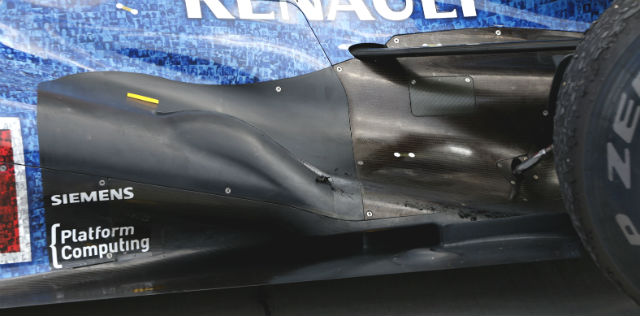
Red Bull further updated the RB8 at its home race, not only with a special livery made up of fans faces (or something like that). The car was more significantly fitted with a revised exhaust exit, with a large bulge in the bodywork.
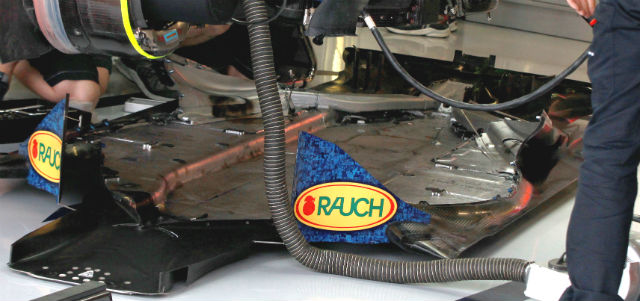
This image gives a good look at the floor of the RB8 – the ducts running from the rear part of the tunnel under the exhaust is clear to see as they run to, and merge at, the starter hole.
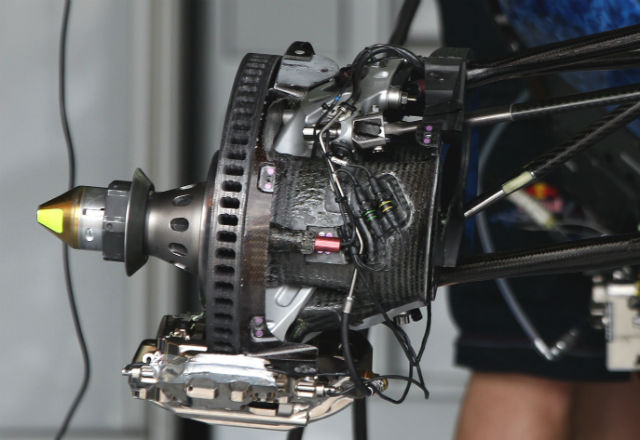
The front brake set up on the RB8 features the caliper mounted at the base of the disc lowering the CofG of the unsprung weight.

A look at the rear suspension of the RB8 which was revised at the European Grand Prix, it seems to be working with the RB8 easily the strongest car at Valencia and Silverstone.
Hockenheim
Car 1: Chassis (not disclosed)
Position: 5th (finished second but a penalty demoted him)
Driver: Sebastian Vettel
Car 2: Chassis (not disclosed)
Position: 8th
Driver: Mark Webber
Christian Horner: “An interesting race. It was really close between Fernando, Sebastian and Jenson throughout, what turned out to be, a two-stop race. We lost a bit of time in the middle stint, when Lewis was un-lapping himself, which possibly allowed Jenson to get ahead at the pit stop, but then Sebastian gave it everything and made a move to get ahead a couple of laps from the finish at his home race. Mark’s afternoon was always compromised by the gearbox penalty he had yesterday. We were aggressive at the first stop; it didn’t work out as we hoped and he seemed to struggle a bit with the long run pace on the harder tyre today with Mark. I think that possibly the lack of running on Friday and key set-up time cost us there. It was also disappointing to receive the penalty after the race but we accept this. We leave Germany with points for both drivers and we maintain our lead in the Constructors’. We will now focus on the next race which is only one week away.”
Red Bull’s increasingly controversial RB8 Formula 1 car has once again been embroiled in a legality debate. This time it centres on the torque map loaded on to the cars McLaren ECU, the FIA’s Technical Delegate Jo Bauer discovered the code ahead of the German Grand Prix and issued the following statement.
“Having examined the engine base torque map of car numbers 01 and 02 it became apparent that the maximum torque output of both engines is significantly less in the mid rpm range than previously seen at other Events. In my opinion this is therefore in breach of article 5.5.3 of the 2012 Formula 1 technical regulations as the engines are able to deliver more torque at a given engine speed in the mid rpm range. Furthermore this new torque map will artificially alter the aerodynamic characteristics of both cars which is also in contravention of TD 036-11. I am referring this matter to the stewards.”
The mid range torque map is critical in optimising the cars exhaust gas flow to get a blown diffuser effect. Whilst it has been widely written that exhaust blown diffusers are banned they are not banned, though the exhaust position and transmission and engine maps are tightly regulated. Most teams are actively working on developing the best blown diffuser solution that they can within the current regulations. This is where Red Bull’s map was deemed to have pushed the envelope according to FIA steward Derek Warwick.
Three hours after Bauer’s report was released the FIA Stewards of the Meeting announced no further action would be taken. Their statement read:
“The stewards received a report from the FIA Technical Delegate, along with specific ECU data from Red Bull Racing Cars 1 and 2. The Stewards met with the team representatives and the representative of the engine supplier Renault.
While the stewards do not accept all the arguments of the team, they however conclude that as the regulation is written, the map presented does not breach the text of Art. 5.5.3 of the Formula One Technical Regulations and therefore decided to take no action.”
Both Warwick and Mercedes Team Principal Ross Brawn said that the issue was “not over” and it seems likely that either a rules clarification or a protest will follow before the end of the August break.
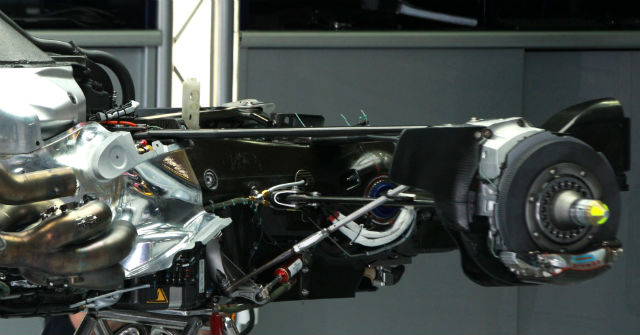
Hockenheim gave us a good look under the bodywork of the RB8, with many components exposed for the first time. In the above image you can see one of the KERS battery units just below the heat shield (the yellow high voltage sticker is partially visible). The pullrod mounting to the damper is also clear to see. What is not clear is the hydraulic linkage that forms part of the RB8’s interconnected suspension system (see RCE V22N1). Finally the new caliper position introduced a few races ago is clear to see on the brake disc.
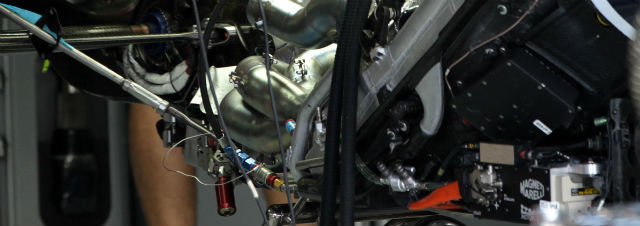
Hungaroring
Car 1: Chassis (not disclosed)
Position: 4th
Driver: Sebastian Vettel
Car 2: Chassis (not disclosed)
Position: 8th
Driver: Mark Webber
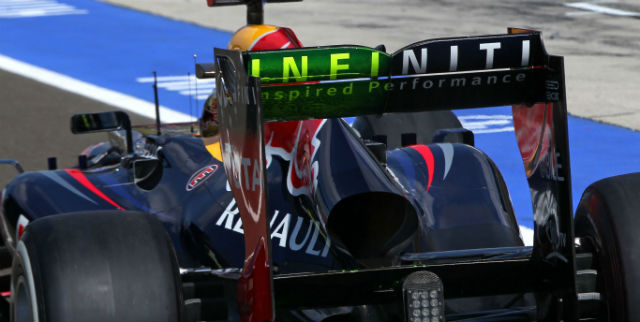
Red Bull did some evaluation work in Hungary, including a study on the rear wing with flow visualisation dye.
Spa-Francorchamps
Car 1: Chassis (not disclosed)
Position: 2nd
Driver: Sebastian Vettel
Car 2: Chassis (not disclosed)
Position: 6th
Driver: Mark Webber
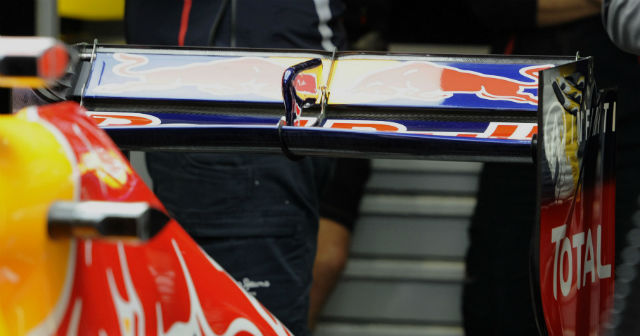
At Spa Red Bull ran in dry sessions with a very low drag variant of its rear wing.
Monza
Car 1: Chassis (not disclosed)
Position: DNF (alternator)
Driver: Sebastian Vettel
Car 2: Chassis (not disclosed)
Position: DNF (tyres)
Driver: Mark Webber
CYRIL DUMONT, Renaultsport F1: “We changed the alternator on Sebastian’s car yesterday, but unfortunately we had the same failure in today’s race. We are still looking into why this happened, but we do know that even though the alternator was being operated entirely within the prescribed range, the part itself overheated and shut off the power supply. We have to apologise to Red Bull Racing as clearly this has hurt us in the Championship. We have no option, but to sort it out and it will still be a priority before Singapore.”
Singapore
Car 1: Chassis (not disclosed)
Position: 1st
Driver: Sebastian Vettel
Car 2: Chassis (not disclosed)
Position: 11th
Driver: Mark Webber
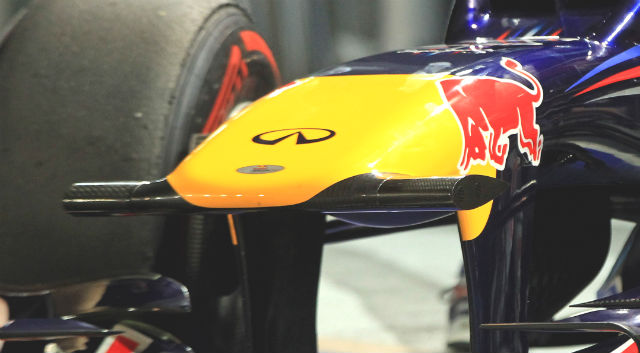
Red Bull arrived in Asia with a new nose as part of a major update package, this new one was slightly lower and a different shape. But more significantly it appeared to be highly flexible, and a number of videos can be found online showing the rubber like qualities it exhibits. Note the bulge under the nose.
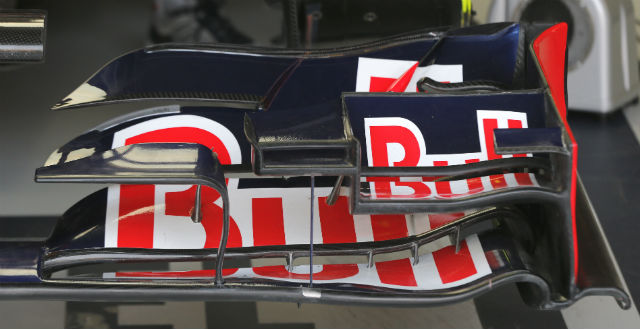
The front wing was also updated compare the new wing (above) with the design used at Silverstone.
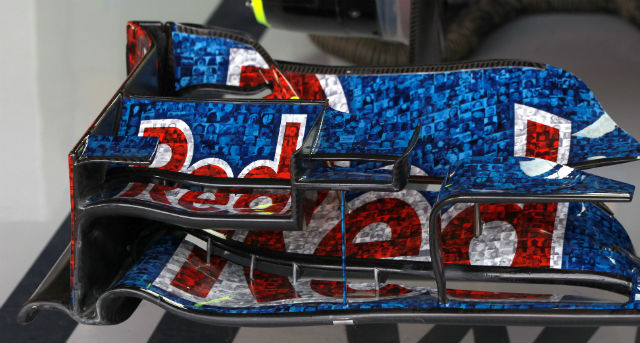
Suzuka
Car 1: Chassis (not disclosed)
Position: 1st
Driver: Sebastian Vettel
Car 2: Chassis (not disclosed)
Position: 9th
Driver: Mark Webber

Red Bull quietly rolled out a double DRS design in Singapore but it was only noticed at Suzuka. Unlike the Mercedes design the RB8 system does not feed air to the front wing instead it stalls the lower beam wing. A much simpler layout but possibly not as effective as the one used by Mercedes.
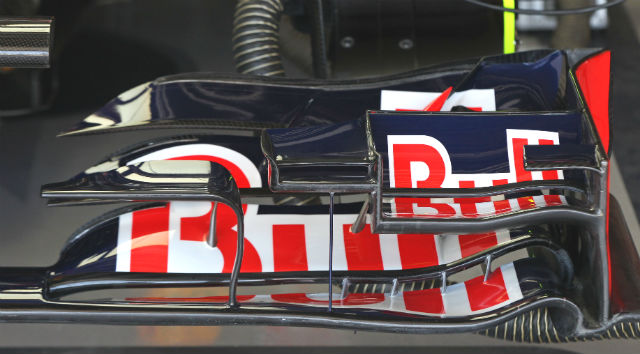
The front wing was again mildly updated, some claim to help the new design pass flexibility tests.
South Korea
Car 1: Chassis (not disclosed)
Position: 1st
Driver: Sebastian Vettel
Car 2: Chassis (not disclosed)
Position: 2nd
Driver: Mark Webber
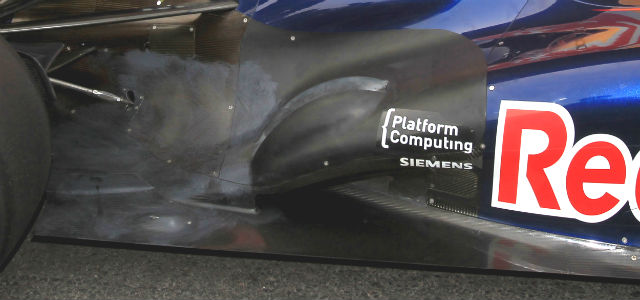
At Korea Red Bull revised the tunnel under the exhaust exit slightly, shortening it. This may be as a result of the implementation of an additional rear wing stalling device.
Buddh International
Car 1: Chassis (not disclosed)
Position: 1st
Driver: Sebastian Vettel
Car 2: Chassis (not disclosed)
Position: 3rd
Driver: Mark Webber
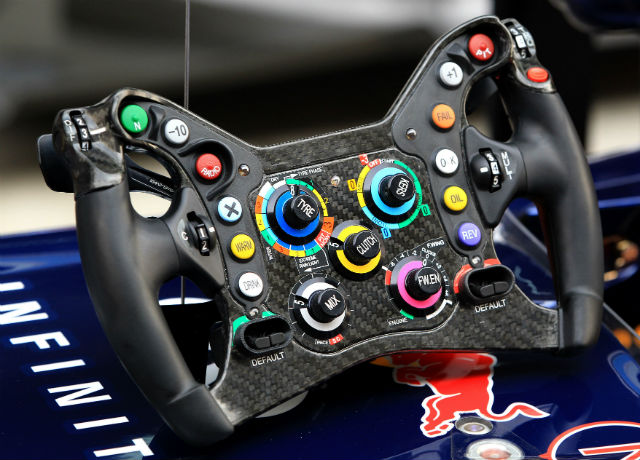
The Indian Grand Prix gave a good look at the RB8’s steering wheel.
Yas Marina
Car 1: Chassis (not disclosed)
Position: 3rd
Driver: Sebastian Vettel
Car 2: Chassis (not disclosed)
Position: DNF (Grosjean)
Driver: Mark Webber
In Abu Dhabi Red Bull ran special Brembo brake discs first seen in are once again using the new Brembo discs. Featuring more than 1000 holes (five holes per row). Made from a new material, CER, they lose only 1mm of thickness by the end of the race in comparison to the 4mm worn away on the older CCR discs. Mounting the calipers at the base of the disc mean that it impossible to bleed the brakes whilst the calipers are still installed on the car.
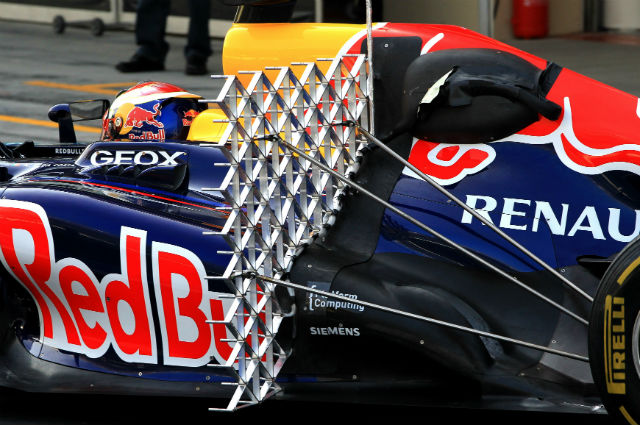
Following the Grand Prix Red Bull stayed at Yas Marina for a young driver test where it ran this huge sensor array.
Circuit of the Americas
WIN WORLD CONSTRUCTORS CHAMPIONSHIP
Car 1: Chassis (not disclosed)
Position: 2nd
Driver: Sebastian Vettel
Car 2: Chassis (not disclosed)
Position: DNF (Electronics / alternator)
Driver: Mark Webber
ADRIAN NEWEY, Chief Technical Officer: “It’s been an amazing year. To achieve the hat trick is a tremendous tribute to the whole team. It shows we’ve managed to keep our standards up and keep consistency. The hard work, the dedication, the talent of the people back in Milton Keynes – that’s what this is all about. I hope they are celebrating and having a drink tonight. We are always thinking how we can improve the car and what we can do in the coming races. It’s been a difficult year and unfortunately my pre-season concerns proved to be right. Having developed the car around side exhaust technology for the last two years, losing that was a bigger step back for us than our competitors and it’s been quite a difficult evolution to get the car back to where we wanted. Getting a third title shows we’re not a flash in the pan; we’ve managed to stay at the top, to understand the car and maintain consistency which is not easy at all. The first title was amazing because when I left McLaren for Red Bull, it was a bit of a career gamble, I was joining with a dream of perhaps trying to win races in the future with the team that I’d been involved with more or less from the start. To actually fulfil that dream and to achieve three titles has been amazing. We can all have dreams, but to do it is something special. It’s not just me personally but it’s the whole team and this is a tribute to everyone within it.”
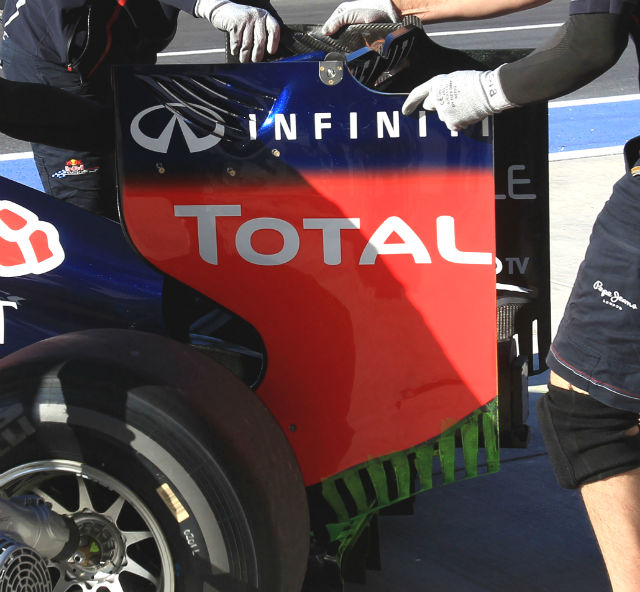
Red Bull brought a new rear wing to Austin with revised elements and a new endplate. Note the Toyota TF109 inspired serrated base to the endplate, covered in flow vis dye in this image.
Interlagos
WIN WORLD DRIVERS CHAMPIONSHIP
Car 1: Chassis (not disclosed)
Position: 6th
Driver: Sebastian Vettel
Car 2: Chassis (not disclosed)
Position: 4th
Driver: Mark Webber
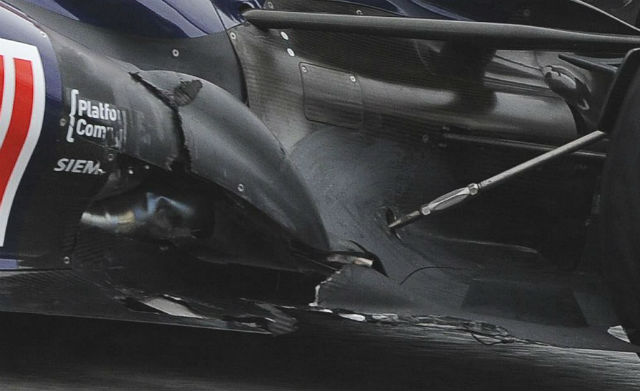
Vettel was very lucky to finish the race at all with extensive damage to the rear of the car – note the crushed exhaust. Adrian Newey studied a picture very similar to this on the pit wall during the race – no wonder he looked worried!
ADRIAN NEWEY: “The whole season has been an amazing ride, but today, to finish it like that down to the wire with so many obstacles – the first lap incident, the concern about the damage to both the bodywork and the exhaust, the fact that the car was then hard on its tyres, the radio failing – was just great; you know, we had so many things thrown against us. I think to come through all that and still get enough points to win the Championship was a real testament to team and driver. For Seb to get three championships, I don’t know how you’d be able to describe that, but I think the hallmark of the year really has been the tenacity shown by the team. We struggled with the car at the start of the year, trying to understand how it worked with the loss of the side exhaust, and to turn around a slightly difficult sub car at the start of the year, to get it to the point where we were able to seal the Constructors’ a week ago and then again here with the Drivers’ – it’s just been a great tribute to everybody.”
